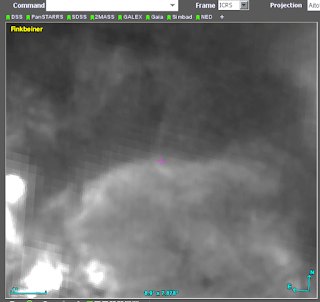While observing with my night vision device, I often notice filaments and clouds of nebulosity extending well beyond the field of view. In my notes I comment how it appears a brighter, cataloged nebulosity is linked to another with a fainter stream. I thought these were probably uncatalogued wisps or part of larger structure I hadn’t heard of. To “see” such structures, the widest field possible is necessary. If one is patient, and an excellent sketcher, super-wide fields can be constructed from multiple fields of view, such as Mel Bartels’ excellent IFM sketches. Of course, astrophotographers stitch together panels to form ultrawide mosaics. Another excellent resource is Finkbeiner’s H-alpha Full Sky Map.
So, I was very curious when reading a post on Cloudy Nights which mentioned a nebula designation I had not seen before, “Siv,” which I found out after some internet searching is for J.P. Sivan of France. In 1974 Sivan published a paper called “A New Look at the Interstellar Hydrogen Through a Very-Wide-Field Photographic H-alpha Survey of the Whole Milky Way.” Sivan used telescopes with a 60-degree field diameter and filters centered on Ha passband of 10 angstroms, with the purpose of visualizing potentially larger nebula structure than prior catalogs, like Sharpless, could see because they had smaller fields. He also thought many of the “classical” designated HII regions were but the brighter portions of larger scale nebula, and so larger fields of view were needed to study them. Sivan lists 11 such nebulae in his paper, all of which are in SIMBAD. I thought this would make a fun observing project for my PVS-14 at 1x and 3x.
During the summer and fall of 2022 I observed these nebulae over several months from a dark sky site on the California Central Coast. The sky was generally dark, 21.3-21.5, but transparency was typically average. 3/5. I pre-printed images of the nebula using the Finkbeiner layer on Aladin. I used my NP-101 at 10x and 4° TFOV with Ha 3nm, Ha+OIII 5nm, OIII 5nm, and 642 longpass filters in a filter wheel, and the PVS-14 at 1x with a Ha 7nm filter, with a 40° FOV. There isn’t much written about these objects in the scientific literature.
Siv 1 In Sagittarius, centered 18 17 12.0 -21 30 00; size: 150’ x 60’ (2° x 1°).
Sivan notes this stream connects Sh2-34 to Sh2-35. With 4-inch and Ha, it was bright, easy, a large oval within an even larger “C” shaped nebulosity linking the two brighter Sharpless clouds. The inside of the “C” was filled with gauzy nebulosity, and there was a large wisp of nebula wafting from the back of the “C.” Nearby is the Lagoon Nebula, which was spectacular.

Siv 2 In Cassiopeia, centered 00 14 36.0 +50 45 00; size: 330’ x 180’ (5.5° x 3°). Distance: 1380 pc.
Sivan noted the exciting star is 9th magnitude AO Cas. Also known as the “Manta Nebula,” there are several good Astro-photographs on the web. This great shot notes the prevalence of OIII emission, and the author speculates it might be a planetary nebula. I found this object extremely difficult using the 4-inch. I only noticed a large, ragged, dome-shaped glow when changing filters from unfiltered to Ha and noticing the “relatively” bright dome. Very tenuous long filaments flowed from the dome to the south, making the nebula look very much like a rag mop. It appeared more readily with the PVS-14 and a 3x magnifier with a front-mounted 3nm Ha filter: the northern dome was well separated from the background, and I could follow the hazy gauze of nebula flowing south. (The Finkbeiner survey coverage is incomplete, so there’s a blank spot in Aladin).
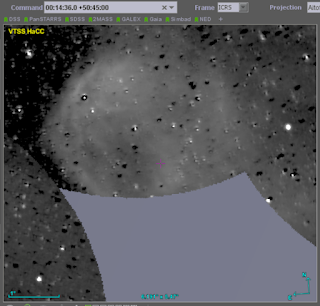
Siv 3 In Camelopardalis, centered 04 57 30.0 +65 29 00, 450 x 240’ (7.5° x 4°), distance 830 pc. Exciting star: alpha Cam (09.5 Ia).
For these very large nebulae, I can only frame them with the widest field possible, otherwise a smaller field would simply make them part of the background sky. Using a monopod to keep the PVS-14 steady, at 1x with Ha filter, I was able to observe a large, extremely faint trapezoid cloud spreading through Camelopardalis NE-SW. One aspect of the filters is they are brighter in the center of the field than the edges, so as one pans from side to side, a nebula at the edge will brighten when it moves to the middle. After looking directly at Camelopardalis for a while and not seeing much of anything, I slowly panned down to some brighter nebula (such as Heart & Soul) to get used to how nebula appear against the background, then panned back to central Camelopardalis, and was able to detect the glow. There’s a good write-up of the area on GalaxyMap (which is a good resource for Ha observing). In the 4-inch I tried pretty hard to see the bow shock in front of Alpha Cam but did not see it. There’s a good write up about this feature on the WISE website.

Siv 4 In Perseus, centered 03 52 24.0 +32 36 00, 540’ x 420’ (9° x 7°).
Sivan notes: “Diffuse region of extremely faint emission, connected to NGC 1499. Barely detected in the mosaic…. Unambiguously revealed by a longer exposure Ha photograph…. This new HII region is found to be associated with an expanding shell of neutral hydrogen discovered by Sancisi (1973), connected with the II Per association.” I observed Sivan 4 with the PVS-14 at 1x with Ha filter, and only by panning the device through the field to notice changes to the sky background. NGC 1499 is very bright and pops into view in the device. Filaments stretch out from the eastern side of NGC 1499 and hook to the south, fading as they go. By following that curve one is led directly toward the star Atik, which is close to the center of Siv 4, and I could see the very large faint glow in this area fairly well. In this image NGC 1499 is to the upper left. The bright nebula on the right is associated with Barnard 3.
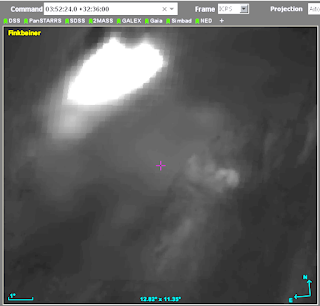
Siv 5 & Siv 6: In Monoceros, centered 07 01 30.0 -02 43 00, Siv 5 is 2° x 1° in size, and Siv 6 is 1.5° x 1°.
Sivan notes: “Possibly associated with the drapery-like region of faint emission which extends from the outer edge of the Barnard Loop.” I saw them both 1x and through the 4-inch with Ha. In both cases I located the very bright Rosette Nebula, then from there “nebula hopped” down some bright Sharpless islands southward (Sh2-280, -282, -284) until I was centered in the region. These were faint but easily seen both 1x and in the 4-inch, with Sivan 5 a large, curved-backed glow with mottling to the south, of which Siv 6 looks like a broken-off puff.
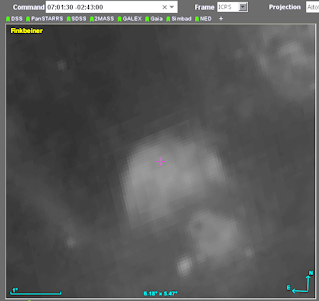
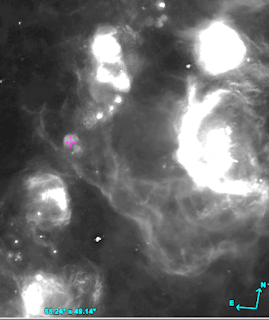
Siv 7: In Ara, below Scorpio’s tail, centered at 17 06 17.7 -46 39 07; size 90’ x 40’ (1.5° x 0.6°).
Sivan notes it is part of RCW 114, aka “Dragon’s Heart” nebula. It appears as a brightening in this large and complex nebulosity. I observed the area with the PVS-14 at 3x with Ha filter, by panning from Sivan 8 in the lower portion of Scorpio’s tail towards the Dragon’s Heart, of which Sivan 7 appears as a bright knot. The larger nebula was more engaging and fascinating, a ball of wisps, some of which separated from the rest and swept to the north.

Siv 8 In Scorpius, centered at 16 43 24.6 -41 23 45, size: 420’x420’ (7° x 7°), distance 2,000 pc.
Sivan notes: “Wheel-shaped nebula, possibly connected to RCW 114 by faint, outlying filaments. Contains RCW 113 and IC 4628. Connected with the Sco OB1 association. The derived linear diameter is 244 pc.” Best seen with PVS-14 at 3x and Ha, it is an obvious, if faint, wreath-shaped cloud, with IC 4628 the Prawn Nebula as a very bright bow on its NE rim. There was a large sheet of nebulosity flowing further south to the horizon, a bright knot of which is NGC 6188. I also examined this through both the 4-inch and saw a lot more wisps and billows, and very excitingly the pillar of dark nebulosity along the northern rim, which looks like a much larger version of the Cone Nebula.

Siv 9: In Scorpius, centered 16 38 36.0 -28 46 00, size 600’x420’ (10° x 7°), distance 182 pc. Sivan notes: “RCW 129 containing the star Tau Scorpii, and fainter extensions.” Using 1x with the night vision device on a monopod, I scanned the sky to move the nebula through the center of the field and watch for brightening. I first noticed the glow after “nebula hopping” from Sagittarius (Lagoon etc.) down above Scorpio’s stinger stars (Cat’s Paw, War & Peace nebula, etc. – all of which were pretty bright) and then over toward Tau Scorpii. The cloud was very large, roughly triangular shaped, considerably faint, with a brighter rim toward Antares but very diffuse in the east.
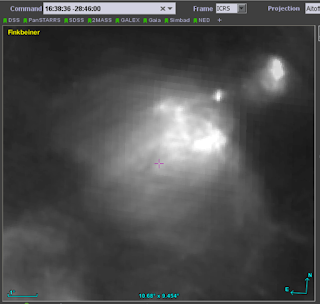
Siv 10: In Scorpius, centered 16 01 00.0 -20 19 00, size 840’x720’ (14° x 12°), distance 174 pc.
This nebula lies in between the Scorpion’s head and Sh2-27, the large bright cloud which many observers with night vision have noticed. It was faint, but obvious, large, round with an arc of brighter nebulosity along its NE rim. The center was mostly diffuse but had a slightly brighter and mottled “core,” and there was a bright puff to the south. Sivan says of it; “Almost circular emission region containing two concentrations, S1 and S7 surrounding the stars Pi Sco and Delta Sco respectively. Appears to be associated with an expanding shell of neutral hydrogen connected with the II Sco association (Sancisi 1973).”
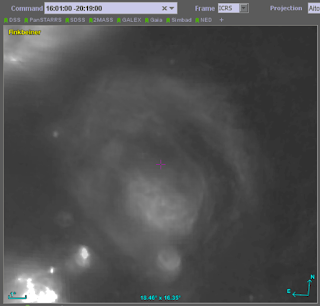
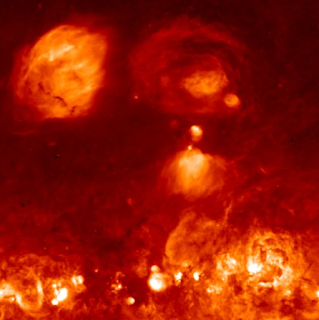
Siv 11: In Scorpius, centered 17 09 06.0 -30 52 00, size 360’ x 60’ (6° x 1°).
Sivan notes: “Double crescent shape. Associated with diffuse background emission, one side bounded by heavy obscuration.” With the 4-inch it appeared as a weak, but very apparent, stream of nebulosity, looking much like a jet contrail with mottling in the body. As an extra treat, the nebula bends slightly to make room for the globular cluster M62, which with the Ha filter and such low magnification was dulled and appeared as a small hazy ball (the view was much more filled with stars with the 685nm longpass filter, but the nebula was lost). The dark cut-off Sivan mentions is very apparent.
